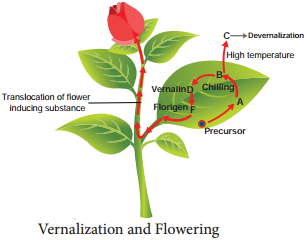Learninsta presents the core concepts of Biology with high-quality research papers and topical review articles.
Vernalization
Besides photoperiod certain plants require a low temperature exposure in their earlier stages for flowering. Many species of biennials and perennials are induced to flower by low temperature exposure (0°C to 5°C). This process is called Vernalization. The term Vernalization was first used by T. D. Lysenko (1938).
1. Mechanism of Vernalization:
Two main theories to explain the mechanism of vernalization are:
- Hypothesis of Phasic Development
- Hypothesis of Hormonal Involvement
1. Hypothesis of Phasic Development
According to Lysenko, development of an annual seed plant consists of two phases. First phase is thermostage, which is vegetative phase requiring low temperature and suitable moisture. Next phase is photo stage which requires high temperature for synthesis of florigen (flowering hormone).
2. Hypothesis of Hormonal Involvement
According to Purvis (1961), formation of a substance A from its precursor, is converted into B after chilling. The substance B is unstable. At suitable temperature B is converted into stable compound D called Vernalin. Vernalin is converted to F (Florigen). Florigen induces flower formation. At high temperature B is converted to C and devernalization occurs (Figure 15.11).

Technique of Vernalization:
The seeds are first soaked in water and allowed to germinate at 10°C to 120°C. Then seeds are transferred to low temperature (3°C to 5°C) from few days to 30 days. Germinated seeds after this treatment are allowed to dry and then sown. The plants will show quick flowering when compared to untreated control plants.
3. Devernalization
Reversal of the effect of vernalization is called devernalization.
4. Practical Applications
- Vernalization shortens the vegetative period and induces the plant to flower earlier.
- It increases the cold resistance of the plants.
- It increases the resistance of plants to fungal disease.
- Plant breeding can be accelerated.
Vernalization (from Latin vernus, “of the spring”) is the induction of a plant’s flowering process by exposure to the prolonged cold of winter, or by an artificial equivalent. This ensures that reproductive development and seed production occurs in spring and winters, rather than in autumn.
Plants often flower in the spring, so, in practical terms, vernalization is the promotion of flowering in response to prolonged low temperatures. This response evolved in plants that adapted to regions where the winters are harsh and the growing season relatively short.
Some examples include beets, onions, winter wheat, cabbage, and turnips. In order to produce flowers and seeds, these plants have to go through a process called vernalization. Vernalization simply means that the plant has to experience a period of cold before it can produce flowers.
In laboratory experiments vernalization occurs at constant temperatures in growth rooms set to between 0 and around 15°C. But real winter temperatures are not constant, and daily fluctuations outside during day and night often exceed the difference in seasonal average temperatures.
Vernalization (from Latin vernus, “of the spring”) is the induction of a plant’s flowering process by exposure to the prolonged cold of winter, or by an artificial equivalent. Typical vernalization temperatures are between 1 and 7 degrees Celsius (34 and 45 degrees Fahrenheit).
Vernalization, the artificial exposure of plants (or seeds) to low temperatures in order to stimulate flowering or to enhance seed production. By partially germinating the seed and then chilling it to 0° C (32° F) until spring, it is possible to cause winter wheat to produce a crop in the same year.
Vernalization is the acquisition of a plant’s ability to flower in the spring by exposure to the prolonged cold of winter, or by an artificial equivalent. After vernalization, plants have acquired the ability to flower, but they may require additional seasonal cues or weeks of growth before they will actually flower.
The site that perceives the cold stimulus can be different in different plants. It could be the apical meristem in the shoots, the germinating seed or the vegetative parts such as leaves.
Many types of plants have vernalization requirements. Many fruit trees, including apples and peaches, require minimum chilling times each winter to produce a good crop. Too warm winters can damage the trees health or even kill them over time.
Winter wheat requires vernalization, a process where plants exposed to cold temperatures experience physiological changes. With wheat this means the plants will not flower until they have been exposed to cold temperatures. Varieties with a higher vernalization requirement need more exposure to cold temperatures.
In absence of cold treatment, accumulation of ent-kaurenoic acid in shoot tip occurs. Cold treatment followed by exposure to high temperatures convert it into GA9, which stimulates flowering response in plants. Thus, gibberellins can substitute the vernalization.
Gibberellins affect several reproductive processes in plants. They stimulate flowering, particularly in long-day plants. In addition, gibberellins substitute for the low temperature that biennials require before they begin flowering (vernalisation).
There are plants for which flowering is either quantitatively or qualitatively dependent on exposure to low temperature, this phenomenon is termed vernalisation. Vernalisation refers specially to the promotion of flowering by a period of low temperature.